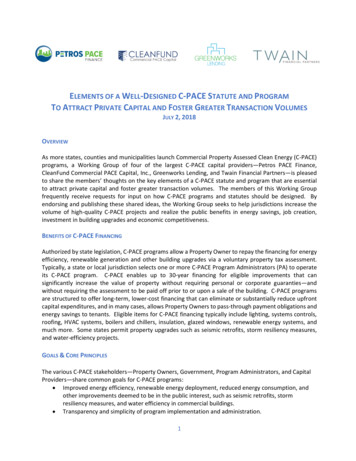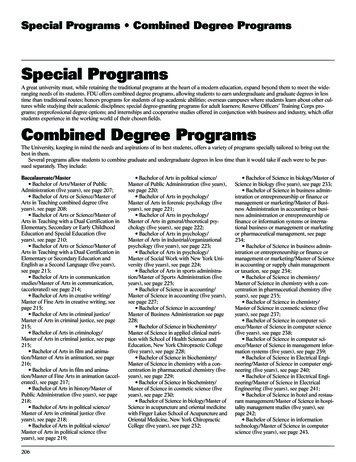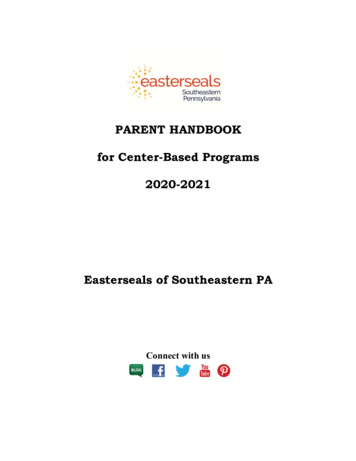
Transcription
ELEMENTS OF A WELL-DESIGNED C-PACE STATUTE AND PROGRAMTO ATTRACT PRIVATE CAPITAL AND FOSTER GREATER TRANSACTION VOLUMESJULY 2, 2018OVERVIEWAs more states, counties and municipalities launch Commercial Property Assessed Clean Energy (C-PACE)programs, a Working Group of four of the largest C-PACE capital providers—Petros PACE Finance,CleanFund Commercial PACE Capital, Inc., Greenworks Lending, and Twain Financial Partners—is pleasedto share the members’ thoughts on the key elements of a C-PACE statute and program that are essentialto attract private capital and foster greater transaction volumes. The members of this Working Groupfrequently receive requests for input on how C-PACE programs and statutes should be designed. Byendorsing and publishing these shared ideas, the Working Group seeks to help jurisdictions increase thevolume of high-quality C-PACE projects and realize the public benefits in energy savings, job creation,investment in building upgrades and economic competitiveness.BENEFITS OF C-PACE FINANCINGAuthorized by state legislation, C-PACE programs allow a Property Owner to repay the financing for energyefficiency, renewable generation and other building upgrades via a voluntary property tax assessment.Typically, a state or local jurisdiction selects one or more C-PACE Program Administrators (PA) to operateits C-PACE program. C-PACE enables up to 30-year financing for eligible improvements that cansignificantly increase the value of property without requiring personal or corporate guaranties—andwithout requiring the assessment to be paid off prior to or upon a sale of the building. C-PACE programsare structured to offer long-term, lower-cost financing that can eliminate or substantially reduce upfrontcapital expenditures, and in many cases, allows Property Owners to pass-through payment obligations andenergy savings to tenants. Eligible items for C-PACE financing typically include lighting, systems controls,roofing, HVAC systems, boilers and chillers, insulation, glazed windows, renewable energy systems, andmuch more. Some states permit property upgrades such as seismic retrofits, storm resiliency measures,and water-efficiency projects.GOALS & CORE PRINCIPLESThe various C-PACE stakeholders—Property Owners, Government, Program Administrators, and CapitalProviders—share common goals for C-PACE programs: Improved energy efficiency, renewable energy deployment, reduced energy consumption, andother improvements deemed to be in the public interest, such as seismic retrofits, stormresiliency measures, and water efficiency in commercial buildings. Transparency and simplicity of program implementation and administration.1
Delivery of long-term, lower-cost financing to the Property Owner that better matches thefinancing costs with anticipated benefits of the improvements over their expected life.Local economic development and vitality.High usage and project volume.These shared goals lead to the core principles that apply to well-designed C-PACE programs.1. Continuous collaboration: C-PACE stakeholders should collaborate on a continuous basis toachieve common goals.2. Input from stakeholders: Policymakers should engage a broad set of stakeholders and take intoaccount best practices learned from other statutes and programs as they craft and amend CPACE legislation.3. Open-market philosophy / freedom of choice: C-PACE programs should encourage open andfree-market competition among Capital Providers, project developers and contractors ratherthan bundling of services.4. Focus on implementation: Once a well-designed statute is enacted, policymakers should providesupport and guidance to the local governments that implement a C-PACE program: Municipalordinances must be adopted and the program supervision must be put in place, which requiresconsidering the role and financial sustainability of a Program Administrator.5. Converge on standards: The C-PACE capital providers should help the industry move towardvoluntary standards to ensure the most efficient, flexible and low-cost access to capital –especially as it relates to matters that can expedite the creation of a liquid secondary market forC-PACE assets.ELEMENTS IN THE C-PACE AUTHORIZING STATUTE AND PROGRAM PROVISIONS1.2.Open Market: Encourages an open market for qualified Capital Providers, project developers andcontractors to compete for C-PACE projects. The statute should not favor or disadvantage a partyin a C-PACE project, although programs may wish to set reasonable minimum qualifications forCapital Providers. If Property Owners are required to obtain an analysis of estimated energysavings, the program should establish qualifications for service providers and foster open-marketcompetition to control costs.Strong Credit Security: Establishes that C-PACE financing entails a special tax assessment on theproperty with certain attributes to create a strong form of credit security:a. Provides that the assessment has a first and prior lien against the real property on whichthe assessment is imposed should the taxes be unpaid.b. Possesses the same priority status as a lien for any other ad valorem tax. If this is notpossible due to political realities, the C-PACE benefit assessment should be subordinateto property taxes but senior to all other government assessments.c.Becomes effective as of the funding of a project, including lien placement prior toany construction period.2
d. Once approved by the PA and recorded, may not be contested on the basis that theimprovement is not a qualified improvement or the project is not a qualified project.e. Non-extinguishable, non-rescindable and non-accelerating.f.May be enforced by the local government in the same manner that a property taxlien against real property is enforced.g. Does not allow for partial payment of property taxes or C-PACE repayments unless suchpartial payment represents a voluntary prepayment.3.Mandatory Approval by Senior Mortgage Holder: Requires approval from all mortgage holders toa C-PACE assessment via written consent or written acknowledgement prior to closing. The seniormortgage holder’s written approval should include a detailed description of the C-PACE financingand a written certification that the financing does not create an event of default under the terms ofthe mortgage. Simply providing notice of the financing to senior mortgage holders is not sufficient.4.No Savings-to-Investment (SIR) Threshold: The Working Group recommends that a statute notrequire a minimum SIR threshold. This recommendation is based on several considerations:a. If the price of energy is low and fluctuating, complying with an SIR test is more difficult;b. an SIR test overlooks the other public benefits in a project such as resiliency, increasedbuilding code compliance, healthier work environments, and increased tenant retention;c. an SIR test may not account for the full benefit of a lower cost of capital; andd. in states where gut rehabilitation or new construction is eligible for C-PACE, the marginalenergy savings over a hypothetical baseline may be wholly inadequate to cover the cost ofthose improvements, thus undercutting a valuable policy tool that could motivate owners tobuild higher efficiency buildings.Finally, landlords may be able charge higher rents for highly energy-efficient space, offsetting a theSIR. For these reasons, the PA should be empowered to approve projects regardless of its SIR.Some programs have used SIR as a rough proxy for determining the property owner’s ability to pay.Standard financial underwriting metrics that capital providers typically employ on a consistent basis(such as a debt service coverage test) are more appropriate to assess creditworthiness, and are oftenwhat the mortgage lender will utilize in evaluating the project to provide consent oracknowledgement. Simply put, if an owner and the property itself have the financial wherewithalto cover the cost of the improvements, C-PACE Programs should encourage this behavior and lookto other financial underwriting checks and mortgage lender consent to guide project financingamounts.If state or local government applies an SIR test, or requires an SIR calculation, the following shouldbe taken into account:a. The estimated savings over the life of the project should include:i.Utility savingsii.Operations & maintenance savings (net avoided spending attributable to the newequipment)iii.Avoided capital costs (if the replaced equipment is nearing the end of its useful life)iv.Avoided fees or penaltiesv.New revenues from renewable energy sourcesvi.Project financial savings where the C-PACE funds displace higher cost capitalvii.Other monetized benefits such as tax credits, utility incentives and rebates3
b. The Capital Provider should be tasked to make the SIR calculation based upon programrequirements and a consistent approach in determining the SIR value. The PA should reviewsuch calculation, but not be required to duplicate the efforts of the Capital Provider indetermining the SIR.5.Flexibility in Financing Terms:a. Allows for the term of the financing to match the useful life of the equipment, up to 30 yearsas allowable by law. This flexibility reduces the repayment burden for long-lived propertyupgrades.b. Allows for renewable energy power purchase agreements or leases to be eligible for C-PACEfinancing or collection via the benefit assessment mechanism, which promotes greateradoption of renewable energy technology.c. Refrains from setting specific financial underwriting parameters, thus allowing capitalproviders to use their own standards to confirm ability to repay.d. Allows C-PACE financing to include the cost of materials and labor necessary for equipmentinstallation, permit fees, inspection fees, application and administrative fees, bank fees,maintenance fees, interest reserves, origination fees, and all other fees and costs incurredby the property owner pursuant to the financing and the project.6.Billing and Collection Process: Identifies the representative of the local government and the taxassessor empowered to collect the C-PACE assessments without personal liability, or alternatively,allows the Capital Provider to bill and collect from the Property Owner directly. The timeframebetween collection of C-PACE payments and remittance to Capital Providers should be minimized,and in any event, no longer than 30 days. Long remittance periods increase costs to the PropertyOwner.7.Program Administrator Permitted: Allows a local government to hire (or contract for) and set areasonable compensation for professional services necessary to administer a program.8.Statewide Consistency: Ideally, encourages program uniformity by creating a statewide programor “district” that local governments can opt into. This multi-jurisdiction structure facilitatesvaluable consistency if the PA adopts best practices.9.Foreclosure Process: Provides clarity and visibility into the foreclosure process for the assessmentand a reliable mechanism to ensure timely commencement of foreclosure.BEST PRACTICES IN PROGRAM ADMINISTRATION1.Clarity of Roles: The PA and the Capital Provider should have clarity about their roles andresponsibilities, which some programs memorialize in a signed contract. The PA’s scope of workshould focus on three essential functions to minimize cost and encourage open-marketcompetition:a. Design the local program rulesb. Certify projects that are eligible and compliantc. Promote the program to stakeholders4
Capital Providers should perform four key functions:a. Cultivate (or Develop) projects / financing opportunitiesb. Apply project underwriting standards consistently and efficientlyc. Coordinate with PAs in the approval, closing, and collection processd. Provide capital to fund projects at competitive rates2.Program Administrators’ services should be priced a la carte. A PA that offers services theProperty Owner can buy on the private market—such as estimating energy savings, overseeingproject development, or evaluating alternative equipment installations—should be pricedindividually. Separate pricing encourages competition and choice. PAs should disclose to thepublic if they have a financial interest in these service providers, and Property Owners shouldhave the option of purchasing these services from any qualified provider.3.Program Administrator Fees and Local Government Fees: PA fees should be reasonable andappropriate in light of various factors such as the size and maturity of the C-PACE market in thesubject state. PA fees structures sold as “no cost to the taxing district, paid for by the borrower”can unintentionally thwart C-PACE transactions if these fees are too high. Many successfulprograms operate with relatively low administration fees, capped per-transaction. For instance,some programs have fees set at 1 percent or less, with per-transaction caps of 75,000 or less.PAs need financial support to cover staff costs until the transaction volume is sufficient to offsetthese expenses. Some PAs obtained start-up grants from philanthropies, utility companies orthe state; other PAs benefited from loaned executives, donated offices, or consulting revenue.Low fees can help new C-PACE markets grow faster, enabling the PA to reach financialsustainability more quickly. Interest rate “add-ons” during the life of the C-PACE financing areanother fee that should be discouraged or be absolutely minimal; generally, a PA’s fees shoulddecline over time as project volume increases. In order to keep fees reasonable, the PA shouldperform only the functions necessary for project approval and administration.4.Creating Program Documents: The PA should collaborate with Capital Providers in creating theprogram documents and the application process, and before changing any of the documentationrequirements. The Working Group recommends that the PA convene stakeholder advisorygroups to solicit input.5.Certification of Project Compliance: The PA or the local unit of government should provide awritten statement on request that the C-PACE financing for a particular property meets theprogram requirements.6.Fair Access by Capital Providers: The PA should do business on the same impartial terms withany party that submits an application. A Capital Provider should be able to submit applicationsto any PA on the same terms and conditions, including situations where the PA is itself affiliatedwith a Capital Provider.7.No Preference among Capital Providers: PAs should not guide a Property Owner to a specificCapital Provider. PAs should refer Property Owners to a list of qualified Capital Providers usinga standard template. If a C-PACE program is administered exclusively by one PA, it is desirablethat the PA not be affiliated with a Capital Provider. If the PA is affiliated, the Capital Provider/PA5
should deal with all other Capital Providers on an impartial, equal basis, taking special care toavoid appearance of conflicts of interest by documenting the intake and handling of inquiries.8.Obtaining Energy Savings Estimates: The PA should encourage Property Owners to obtain anestimate of the potential energy savings from a qualified third-party firm. (As noted above, theWorking Group believes an energy analysis should be for the Property Owner’s informationrather than an SIR test to determine eligibility for C-PACE financing.) The PA should set thequalifications for the third parties approved to perform this work. If the analysis is required bystatute, the PA should review the quality of the energy engineer’s technical work. Some PAshave staff expertise to perform energy savings analysis. However, the PA should price thisservice a la carte and should not favor its services over other qualified external firms.9.Underwriting by Capital Providers: Allows Capital Providers to perform the financialunderwriting to confirm the Property Owner’s ability to repay the assessments. PAs should notdo any financial underwriting, because it duplicates the Capital Providers’ work with no marginalbenefit.10.Financing Agreement from Capital Provider: A program should permit a Capital Provider totailor its financing agreement to meet the needs of the Property Owner and institutionalinvestors, as long as the agreement complies with statutory and program rules. PAs shouldprovide a checklist of statutory and local requirements that must be incorporated.11.Efficient Closing Process: Creates a closing process that is predictable, transparent and efficient.Most Capital Providers transfer the C-PACE financing to a secondary institutional investor afterclosing, so a smooth transfer process is also important. When the PA and Capital Providers canset reliable closing dates, planning and efficiency improves significantly. Predictability is crucialfor Capital Providers and investors. The closing process must also be in a proper order for CapitalProviders, for example, the tax assessment must be in place before (or contemporaneously with)the project’s funding.12.Property Owner’s Satisfaction with the Work of Third Parties: A program should acknowledgethat Property Owners are solely responsible for the selection of contractors and any other thirdparties involved in completing their projects.13.Billing Timeframe and Fees: If C-PACE repayments are billed with the regular property tax bill,tax collectors should establish timeframes and reasonable fees for receipt of C-PACE repaymentsand for remittance to the Capital Provider. The procedure and timeline for the remittance offunds collected by tax assessors to Capital Providers should be included in either the enablingPACE law, the tax assessment document recorded on the property records to evident the PACEassessment, or both.14.Continuous Improvement: The PA should lead the design and periodic review of the process tosubmit applications, determine program eligibility, and obtain approvals. PAs should avoidcreating rules that are impractical or high-cost. Contracts between the municipality and PAsshould specify minimum acceptable levels of service performance, with the ability for PAs to bereplaced for repeated failure to deliver services in a timely manner or adhere to the programguidelines, roles and responsibilities (preferably as outlined in this document).6
15.Standard Form Assessment Contract: If applicable, the PA should help create and maintain astandard form of tax assessment contract (or similar) between the local unit of government andthe Property Owner that clearly defines the method of collection of assessments.16.Procedures for Delinquencies and Foreclosures: The PA should provide clear guidance on (a)the process for curing delinquencies and (b) the foreclosure process to enforce the C-PACEassessment and rights. Ideally, this process involves a contractual obligation to file a foreclosureaction or sell a tax certificate with minimal delay, and allows the right to pursue remedies to beassigned to the Capital Provider. The PA should publish a program handbook setting forth thecollection and foreclosure processes and timelines.17.Payments Process: For those transactions and related payments that are not received by theCapital Provider through direct billing, collection of C-PACE payments should be into a controlledlockbox, with a third-party remittance firm ensuring proper flow-through of payments to theCapital Provider. The design of a remittance framework should ensure that funds will not belost, stolen or displaced.18.Replicability: The PA should develop a turn-key program (with documents available on itswebsite) that other counties and municipalities within the state can adopt.ELEMENTS IN MARKETING, EDUCATION & TRAINING1.Message: The marketing message should emphasize that C-PACE is an alternative financing tool,as well as a means to promote the adoption of renewable energy and efficiency projects.2.Marketing (General Awareness of C-PACE): If resources and time permit, the PA should raiselocal community awareness of the C-PACE program through websites, flyers and local media.The private stakeholders should help market C-PACE as well.3.Education (Explanation of C-PACE Financing and Approval Process): The PA should offerseminars and speak at public events to explain the program to Property Owners, contractors,and economic development organizations. Stakeholders should assist with education.4.Training (For Qualified Energy Savings Analysts or Project Developers): If the PA keeps a list ofqualified third-parties to conduct energy savings analysts or project development, then the PAmust take responsibility for organizing technical training for contractors and engineers. Theseservices can be paid for with a separate fee to contractors and engineers to cover the PA costs.***7
1 ELEMENTS OF A WELL-DESIGNED C-PACE STATUTE AND PROGRAM TO ATTRACT PRIVATE CAPITAL AND FOSTER GREATER TRANSACTION VOLUMES JULY 2, 2018 OVERVIEW As more states, counties and municipalities launch Commercial Property Assessed Clean Energy (C-PACE) programs, a Working Group of four of the largest C-PACE capital providers—Petros PACE Finance,










